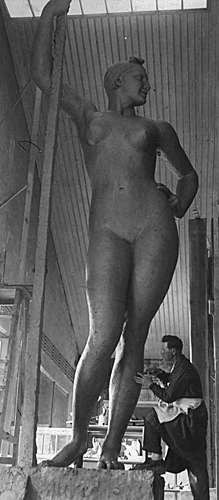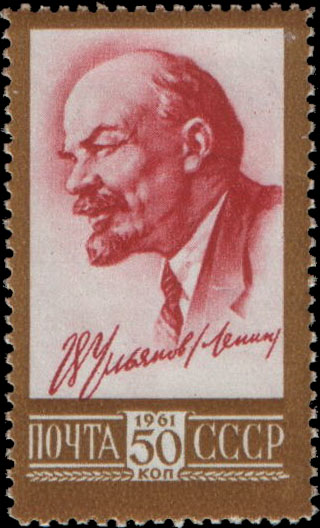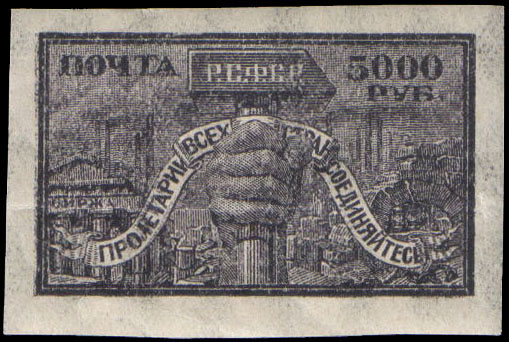|
70r Red Army Soldier Error
The 70r Red Army Soldier error or RSFSR 70r error of 1922 is one of the rarest postage stamps issued by Soviet Russia. Due to the double printing error, one cliché of the imperforate 25-stamp sheet has a 70-ruble value instead of the correct 100-ruble. Only four intact complete sheets are known. Description The sheets contain 25 imperforate 100-ruble orange stamps depicting the Red Army soldier that appeared in the RSFSR 1922 Workers and Soldiers definitive issue. The twelfth stamp in the sheet has a denomination of 70 rubles, unlike all the others, which have a face value of 100 rubles. Rarity Only four complete sheets of 25 exist, including one in the state collection of the A.S. Popov Central Museum of Communications in Saint Petersburg, Russia. As promoted by the Museum, "the celebrated Red Army Soldier of the 1922–23 standard issue is a well known world class rarity." These standout items are dubbed as "one of the greatest rarities in Russian philately". They re ... [...More Info...] [...Related Items...] OR: [Wikipedia] [Google] [Baidu] |
Ivan Shadr
Ivan Shadr (russian: Иван Шадр), pseudonym of Ivan Dmitriyevich Ivanov (russian: Ива́н Дми́триевич Ивано́в; — 3 April 1941) was a Russian/Soviet sculptor and medalist who took his pseudonym after his hometown of Shadrinsk. Biography Shadr studied at the Artistic Industrial School in Yekaterinburg from 1903 to 1907, and from 1907 to 1908 at the Drawing School of the Imperial Society for the Encouragement of the Arts in St Petersburg where the famous Nicholas Roerich was his teacher. He furthered his education under Auguste Rodin and Emile-Antoine Bourdelle in Paris (1910–1911), and in Rome (1911–1912). Shadr's early works, such as the project for the Monument to the World's Suffering (1916), were designed according to the principles of Art Nouveau. After the 1917 Revolution he was an active participant in the execution of the Monumental Propaganda Plan, in particular, he sculptured reliefs depicting the Socialist ideological leaders ... [...More Info...] [...Related Items...] OR: [Wikipedia] [Google] [Baidu] |
Russia
Russia (, , ), or the Russian Federation, is a transcontinental country spanning Eastern Europe and Northern Asia. It is the largest country in the world, with its internationally recognised territory covering , and encompassing one-eighth of Earth's inhabitable landmass. Russia extends across eleven time zones and shares land boundaries with fourteen countries, more than any other country but China. It is the world's ninth-most populous country and Europe's most populous country, with a population of 146 million people. The country's capital and largest city is Moscow, the largest city entirely within Europe. Saint Petersburg is Russia's cultural centre and second-largest city. Other major urban areas include Novosibirsk, Yekaterinburg, Nizhny Novgorod, and Kazan. The East Slavs emerged as a recognisable group in Europe between the 3rd and 8th centuries CE. Kievan Rus' arose as a state in the 9th century, and in 988, it adopted Orthodox Christianity from the ... [...More Info...] [...Related Items...] OR: [Wikipedia] [Google] [Baidu] |
Postage Stamps Of The Soviet Union
Stamps of the Soviet Union were issued in the period 1923 to 1991. They were labeled with the inscription russian: "Почта СССР" ("Post of the USSR"). In the thematics, Soviet stamps reflected to a large extent the history, politics, economics and culture of this world's first socialist state. Notable designers of Soviet postage stamps were Ivan Dubasov (who designed the Lenin Mourning issue, the first stamps portraying Vladimir Lenin in 1924) and Vasily Zavyalov. By the mid-1970s, over 4,000 stamps came out in the USSR. In 1970, the '' Catalogue of Postage Stamps of the USSR, 1918–1969'' was published in Moscow, the yearly supplements being produced afterwards. The history and design of Soviet postage stamps were elucidated in the annual publication '' Soviet Collector'' and the monthly magazine '' Filateliya SSSR''. First stamps The first postage stamps of the newly proclaimed Union of Soviet Socialist Republics were designed by Georgy Pashkov and issue ... [...More Info...] [...Related Items...] OR: [Wikipedia] [Google] [Baidu] |
Postage Stamps
A postage stamp is a small piece of paper issued by a post office, postal administration, or other authorized vendors to customers who pay postage (the cost involved in moving, insuring, or registering mail), who then affix the stamp to the face or address-side of any item of mail—an envelope or other postal cover (e.g., packet, box, mailing cylinder)—that they wish to send. The item is then processed by the postal system, where a postmark or cancellation mark—in modern usage indicating date and point of origin of mailing—is applied to the stamp and its left and right sides to prevent its reuse. The item is then delivered to its addressee. Always featuring the name of the issuing nation (with the exception of the United Kingdom), a denomination of its value, and often an illustration of persons, events, institutions, or natural realities that symbolize the nation's traditions and values, every stamp is printed on a piece of usually rectangular, but sometimes triangular ... [...More Info...] [...Related Items...] OR: [Wikipedia] [Google] [Baidu] |
Soviet Union Stamp Catalogue
Soviet Union stamp catalogue (or CPA catalogue) is a national catalogue of the RSFSR and USSR postage stamps and miniature sheets, which was being published in the USSR by the (CPA) and some other publishers related to the Ministry of Communications. The catalogue usually republished in corpore around once in a 10–15 years. In between republications, additional issues came out every year. These issues contains descriptions of stamps and miniature sheets issued in USSR last year. History Early issues The first Soviet catalogue appeared in 1923 under the editorship of Feodor Chuchin. In what follows, several more catalogues were published under his editorship in 1920s. Fourth edition of the Soviet Philatelic Association catalogue published in 1933 under the editorship of also included a listing of the USSR as well. Postwar issues In 1948 and 1951, two more catalogues of the USSR postage stamps were published by the Philatelic Bureau under the Book-selling Association ... [...More Info...] [...Related Items...] OR: [Wikipedia] [Google] [Baidu] |
Soviet And Post-Soviet Postage Rates
Soviet and post-Soviet postage rates in Russia changed multiple times in the period 1917 to present. They have been introduced by the Soviet and Russian Federation governmental organs and agencies and reflected in alteration of stamp denominations. Historical notes The issue of Russian postage stamps is directly related to postage rates in force at given times during the history of the Russian postal service. Stamp denominations were applied to meet a public need to pay postage costs according to the current rates. Issuing values for the revenue generation was not a purpose of the state policy in this area. Change of postage rates is an important aspect in studying the Russian postal history and collecting its items. Russian postage rates, especially those of the Soviet times, have not been thoroughly researched in philatelic literature. This part of the Russian postal history is less studied, with comments appearing within some other context. Alteration of the postage rates ... [...More Info...] [...Related Items...] OR: [Wikipedia] [Google] [Baidu] |
Postage Stamps And Postal History Of Russia
A Russian Empire postman. This a survey of the postage stamps and postal history of the Russian Empire, the Soviet Union and the modern Russian Federation. Postal history Early history Records mention a system of messengers in the 10th century. Early letters were carried in the form of a roll, with a wax or lead seal; the earliest known of these seals dates from 1079, and mentions a governor Ratibor of Tmutarakan. The earliest surviving cover was sent in 1391 from La Tana (now Azov) to Venice. By the 16th century, the postal system included 1,600 locations, and mail took 3 days to travel from Moscow to Novgorod. In 1634, a peace treaty between Russia and Poland established a route to Warsaw, becoming Russia's first regular international service. Russian Empire Peter the Great enacted reforms making the postal system more uniform in its operations, and in 1714 the first general post offices opened in Saint Petersburg and Moscow. “Regular post-service” was estab ... [...More Info...] [...Related Items...] OR: [Wikipedia] [Google] [Baidu] |
List Of Postage Stamps
This is a list of postage stamps that are especially notable in some way, often due to antiquity or a postage stamp error. Among the best-known stamps are: * Penny Black (Great Britain) * Treskilling Yellow (Sweden) * Bull's Eye (Brazil) * British Guiana 1c magenta * Mauritius "Post Office" * Inverted Jenny (United States) * Basel Dove (Switzerland) Current political entities Austria * Red Mercury – newspaper stamp Belgium * Leopold with the Epaulettes (1849) * Inverted Dendermonde (1920) Bermuda * Perot provisional Brazil * Bull's Eye * Goat's Eye Canada * Canada 12d black * Canada 2c Large Queen on laid paper – Rarest Canadian stamp * Bluenose * St. Lawrence Seaway invert *Canada Scott 10 – 6d Deep Reddish Purple Pence 1857 *Canada Scott 13 – 6d Perforated Pence 1859 *Canada Scott 40e – Ten Cent Small Queen Pale Milky Rose Lilac First Montreal Printing 1874 China * Red Revenues – 1897 provisionals, issued by the Qing dynasty * Big Dragon stamp ... [...More Info...] [...Related Items...] OR: [Wikipedia] [Google] [Baidu] |
Gold Standard Issue
The Gold Standard issue or Small Head issue was the first definitive series of postage stamps issued by the Soviet Union between 1923 and 1927. The stamps were designed by Ivan Shadr. History The RSFSR Government re-issued definitive stamps with regular frequency. By the time of the formation of the Union of Soviet Socialist Republics, with its more than 200 million inhabitants, there was an urgent need for more stamps of various face values that would reflect the change of the state name. New stamps were also required due to the monetary reform in the Soviet Union and the introduction of the chervonets (equal to 10 roubles), backed by the gold standard. The first definitive series of postage stamps, which the Russians themselves name "standard series", was issued by the newly formed USSR in October 1923. Because its face values corresponded to the introduced gold standard, the series usually goes under the name of "Gold Standard". These stamps are also known as "Small Head" ... [...More Info...] [...Related Items...] OR: [Wikipedia] [Google] [Baidu] |
First USSR Stamps
The first USSR stamps or First All-Russia Agricultural Exhibition issue appeared in August 1923 as a series of Soviet Union postage stamps. Its designer was the Russian artist Georgy Pashkov. History The First All-Russian Agricultural and Handicraft Exhibition was held in Moscow in 1923. It was opened on 19 August. This very day, a special commemorative series of postage stamps dedicated to the exhibition opening was released. These were the first stamps of the Soviet Union. Stamps The stamp design was created by the artist G. Pashkov. The stamps have the inscription in russian: "CCCP" ("USSR") or "Почта CCCP" (''Post of the USSR''), the value, and the words in russian: "Всероссийская сельско-хоз. и кустарно-пром. выставка" (''All-Russian Agricultural and Handicraft Exhibition''). They were produced by lithographic printing in two versions, imperforate and perforated A perforation is a small hole in a thin material or ... [...More Info...] [...Related Items...] OR: [Wikipedia] [Google] [Baidu] |
Definitive Stamps Of The Soviet Union
Definitive stamps of the Soviet Union were the regular postage stamp issues produced in the USSR between 1923 and 1992. First definitive issue The first issue of the Soviet Union definitive stamps appeared in October 1923. It was known as the Gold Standard issue. Its stamps bore the busts of the worker, Red Army man and peasant. In the period between 1923 and 1926, the worker and soldier designs were placed on thirteen stamps each and that of the peasant on ten stamps. File:The Soviet Union 1923 CPA 99 stamp (1th standard issue of Soviet Union. 1th issue. Worker).jpg, Worker File:The Soviet Union 1923 CPA 100 stamp (1th standard issue of Soviet Union. 1th issue. Peasant).jpg, Peasant File:The Soviet Union 1923 CPA 101 stamp (1th standard issue of Soviet Union. 1th issue. Red Army man).jpg, Red Army man Other notable issues In 1929, the third set of definitive stamps was issued. They had new images of the male and female workers, male and female collective-farm workers, ... [...More Info...] [...Related Items...] OR: [Wikipedia] [Google] [Baidu] |
Definitive Stamps Of Russia
Definitive stamps of Russia are the regular postage stamp issues produced in the Russian Empire and RSFSR between 1857 and 1923, and in the Russian Federation since 1992. Russian Empire The Russian Empire started issuing definitive series of postage stamps since 10 December 1857 when the first Russian stamp went on sale. There were twenty definitive issues produced until 1917 as outlined in a table below. RSFSR The first definitive series of the RSFSR was issued in 1921. It included five designs of new Soviet symbols such as agricultural labour, industrial labour, science and arts, hammer and sickle, and . The stamps had a minimum wording, russian: Почта (''Pochta'' (postage)) and the acronym russian: РСФСР (''RSFSR''), imparting the Soviet messages solely via pictures. File:1921 CPA 3.jpg, Symbols of agricultural labour File:1921 CPA 4.jpg, Symbols of agricultural labour File:1921 CPA 5.jpg, Symbols of industrial labour File:1921 CPA 6.jpg, "Hammer and sickle ... [...More Info...] [...Related Items...] OR: [Wikipedia] [Google] [Baidu] |

.jpg)




.jpg)

